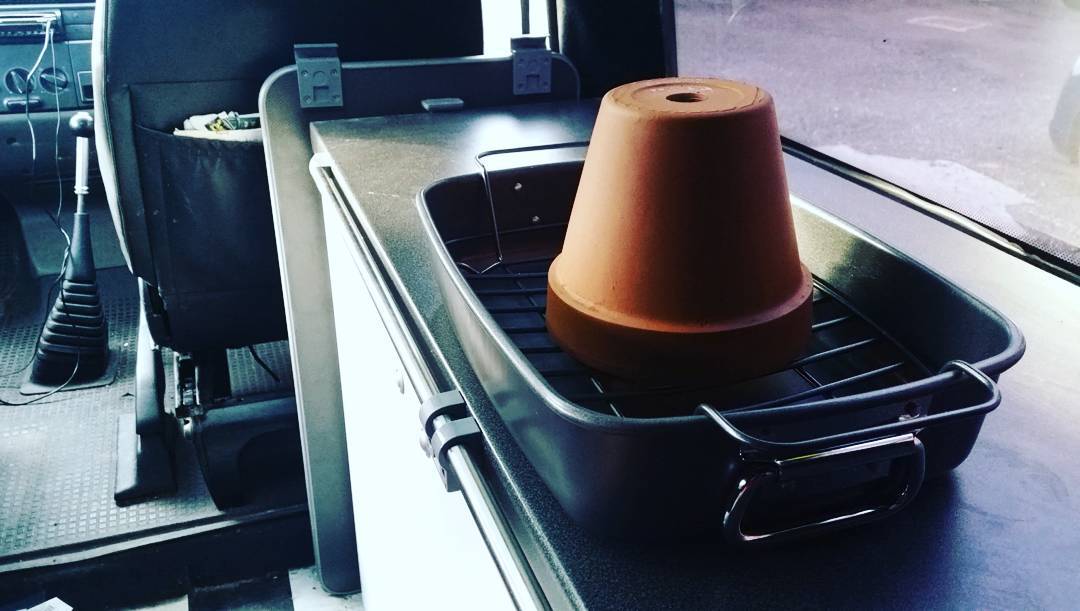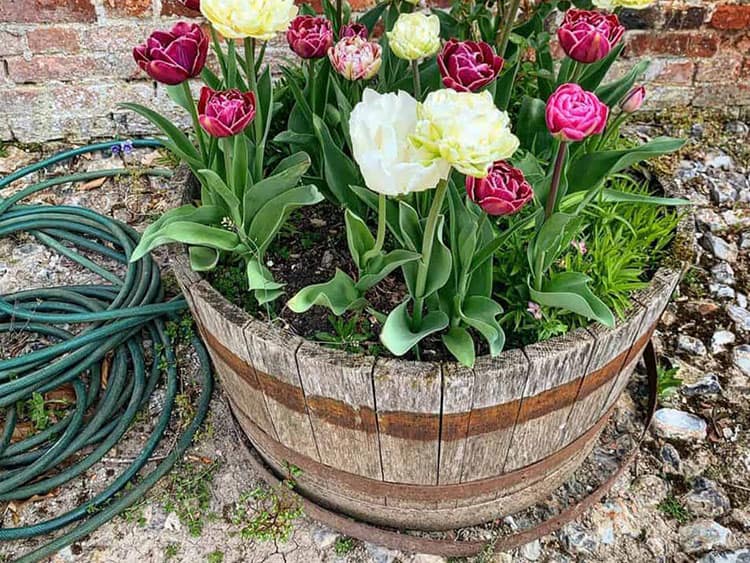You don’t need a huge garden to grow vegetables, a sunny windowsill or balcony can be home to a great selection of pot-grown edible plants. You can enjoy tasty homegrown food from May to October and some of these plants will even continue into winter.
Here are 14 vegetables that you can grow with ease in a pot, helping you to create a varied flower pot vegetable garden.
1. Salads

Image credit: @colourclothandcatnaps
Salads need nutritious soil and will grow well in a pot outdoors from May onwards. Lettuce can be grown indoors all year round as long as there is enough light from a sunny windowsill or grow light. Sow the seeds thinly, water them in well and cover them with a thin layer of soil. Keep the pot in a sunny position and water frequently during hot weather.
Colourful salads include radicchio and mixed salad seed packets. Some varieties have leaves that grow back after picking, allowing you to enjoy fresh salad for months.
Others, like lettuce, form heads that will take up more space than cut-and-come-again types. As you pick a head of lettuce, plant a few more seeds and you should have leaves to pick all summer long.
2. Carrots

Image credit: @steve_d31
Carrots need stone-free soil to create those long tapering roots so they’re a real winner in a pot. Just add a bag of compost without stones and get planting.
The tiny seeds fly away easily so don’t plant them on a windy day! As they start growing little feathery leaves, you’ll notice a dash of orange as the roots develop. You can pick some small carrots to thin out your plants and eat them. They are great chopped into coleslaw, freshly grated on salads or just eaten raw.
3. Radishes

Image credit: @dirt_94>
Radishes are a great salad ingredient and they grow really rapidly. They’re a rewarding crop for children to grow as they quickly have something to show for their efforts.
Sow radish seeds thinly around the pot and water them in well. Cover with a light sprinkling of soil and watch for the new growth. They will soon swell into round shapes with bright red colours that will delight the younger members of the gardening club. Getting them to eat them is the next challenge!
4. Spinach

Image credit: @freshlypottedplantprob
Spinach grows in any weather conditions and in southern England you can grow it all year round. Spinach provides a good source of iron, so it’s well worth growing some seeds in the autumn and winter to add to your dishes.
The great thing about spinach is that the more you pick, the more it grows back. Make sure to plant some seeds in August for your winter vegetable supply. It self seeds beautifully too so if you want to put some in a bigger space, collect the seeds and plant them.
5. Peas

Image credit: @fionaanncrooks
Peas will grow well in a pot but you need to remember that peas climb like crazy, producing tendrils to catch onto any support available. It’s a good idea to put some sticks, bamboo canes, or a support trellis in place when you plant the seeds. That way, you won’t disturb the roots by poking sticks into the soil where they are germinating.
The support can also act as a deterrent for birds hoping to snack on fresh pea growth. Mice also enjoy nibbling new peas so if this is a problem, move them indoors for the first few weeks while they establish. Flowers will soon turn to pods and you will see small peas forming inside. When they are bursting out of the pod, open one to check the size. Pick them and eat them as soon as you can because the sweetness turns to starch the longer they are left.
6. Tomatoes

Image credit: @matka_polka_czarownica
Tomatoes are perfect for windowsills, balconies and patio pots. Smaller varieties are probably best unless you have an enormous pot. Choose a sunny position outside or a south-facing window and make sure the new shoots can be tied onto some support as they grow upwards.
The soil must have good drainage and if it isn’t rich, your tomatoes will be tiny. Feed the plant with a weekly high nitrogen feed to encourage fruiting. If you have comfrey growing in your garden, you can use some leaves to make a tomato feed. See how to do this below.
7. Minipop sweetcorn

Image credit: @alexnoodle
Minipop sweetcorn is great fun to grow with children. The size of the cobs is ideal for lunch boxes and quite easy to grow. In late April or early May, sow 6 seeds per pot 2 inches apart. You can start them off in a small pot and transplant them to a bigger pot as they grow.
Small green shoots will arrive after about a week and the roots grow rapidly so if you notice roots at the bottom of the pot, give them a larger pot and plant them close together in a clump. Corn is wind-pollinated as the tassels on one cob shed onto another close by.
The minipop version is not so tall and will grow nicely in a pot but make sure it gets plenty of direct sunshine every day and be generous with the watering. These plants are native to Mexico so avoid frost by putting your pot outdoors when all risk has passed. The little cobs are delicious eaten raw or cooked and you often see them in delis.
8. Outdoor cucumbers

Image credit: @tmarrinan
Outdoor cucumbers grow well in pots as long as the pot is big enough, the soil has lots of nutrients and you water them frequently. The pot needs to be at least 30cm deep but the bigger the better. Before you plant the seeds, make sure you have a trellis system in place or use bamboo. The plants will grow quickly and you will need to tie in the stems as it grows.
If planting before March, start it off indoors with a heated propagator if you have one. Once the seeds sprout, give them lots of sun and water at least once a day. As the flowers develop, it’s a good idea to feed the plant with fertiliser. This can be homemade (see below) or you can add a slow-release fertiliser, like pelleted chicken manure, to the soil at planting time.
9. Leeks

Image credit: @natalie_s_journal
Leeks grow well in flower pots but you need to remember how long they take to mature. You can sow seeds in spring which need to be planted into a bigger plot about a month later then left to mature.
If planted in February, you can probably pick leeks late in the autumn. The longer you leave them, the thicker the stem will grow. If you want a dash of colour in your leek pot, you can also add small, annual flowers to make it more interesting as the leeks grow.
10. Achocha (or Potol)

Image credit: @krafft.kitchen
Achocha is a little known vegetable that is often regarded as invasive in Asia and warmer climates but here in the UK, you can pop some seeds in a pot and you will have tasty green veg all summer long until the first frosts arrive.
This unusual vegetable is one that really surprised me last year, and I will never have another growing season without it! You can eat the fruit cooked in soups, as a vegetable and pickled in a sauce but it is the sheer quantity of fruit you get that is my main reason for growing it.
If you cut and freeze it you can have a freezer full to get you through those cold winter months too. Give it direct sunshine, and some support to grow. You can save the pretty black seeds and use them for craft activities too.
11. Squash and Pumpkin

Image credit: @meganinthegardenmelbourne
Squash and pumpkin need a large pot and they grow very long stems, up to 10 feet. If you have space for them to adorn a balcony with their gorgeous yellow flowers, then trail the stems along the edge and tie them in as they grow.
The developing squash fruit will need some support if it isn’t lying on the ground. The flowers are wonderful for bee and butterfly visitors, as well as providing good colour. Feed the plant regularly as the fruits develop and make sure you pick them before the first frosts.
12. Beetroot

Image credit: @the.tinyfarmer
Beetroot is easy to grow in a pot. The leaves make a tasty snack too. Make sure the soil is stone free or the root will grow around them. It’s hardy too so this one can be left outdoors all year round.
Harvest when the plump roots can be seen and cook them gently before eating. Beetroot is delicious added to salads, roasted, and also in borscht, Russian beetroot soup. The soup is a fantastic pink colour and is guaranteed to warm up any winter day. See my recipe below.
13. Garlic

Image credit: @gardenandfood2022
Garlic is so easy to grow in a pot. Just separate a garlic glove into bulbs and sew them with the pointed end upwards. Plant it in the autumn because it needs a period of cold weather.
The bulb will produce roots underground all winter and in spring, the bulb will develop into a full clove. Homegrown garlic makes excellent garlic bread too.
14. Herbs

Image credit: @ursulamaxwelltravels
Herbs aren’t strictly vegetables, but as herbs are used to add flavour to all the other growing vegetables, I think they can be included in a flower pot vegetable garden. Try parsley, coriander, lovage, chives and thyme, all of which grow well in pots.
Herbs also provide gorgeous scents as you walk around your house or patio or balcony. There are some varieties such as Hamburg parsley, which provides leafy green growth above ground and a root that can also be eaten like a parsnip. It’s completely hardy too so you can enjoy winter greens.
You might like: 10 of the best herbs to grow in a planter box
Tina’s Tips
- Make your own plant feed: Most commercial plant feeds contain NPK; nitrogen, phosphorus and potassium. The leaves of many garden weeds can provide these elements if soaked in water. Check your garden for any useful weeds like nettles, dandelions, meadowsweet, plantain, silverweed and comfrey. Pick a handful of leaves and add these to a bucket of water. Leave it alone for a week and the minerals from the leaves will seep into the water. Strain the leaves and fill a watering can with the liquid. It usually smells foul so make sure that bucket is situated away from your patio but your plants will love it! You can use this feed on any of the plants above to encourage larger vegetables.
- Use your beetroot to make borscht:

Image credit: @clemhf10
You will need 3-4 beetroots, stock, some cream to serve and herbs and salt to season.
- Skin the outsides of the beetroot, chop and place them in a saucepan of water to cook for about 15 minutes.
- Check if they are cooked by testing with a fork. If they are soft, they are ready.
- Add some salt and herbs to season. Russian recipes use meat stock at this stage but if you are vegetarian or vegan you can use spice mixes without meat content.
- Whizz the beetroot in a blender until you have a smooth consistency.
- To serve, swirl some cream into the centre of the bowl. Finish with a parsley garnish and hey presto! Tasty homemade soup.
You might also like: 11 easy vegetables to grow indoors in winter

Save this pin for later






